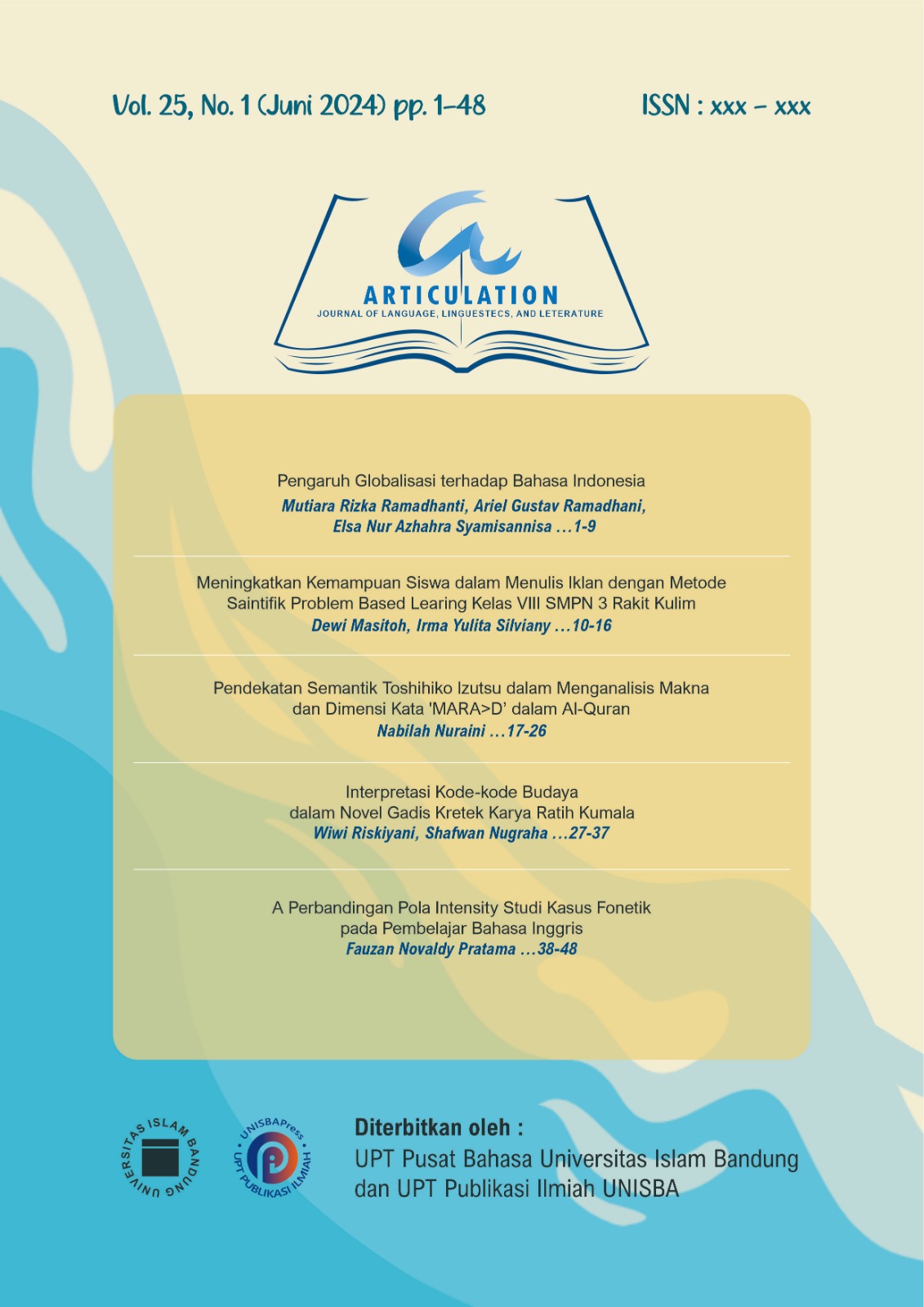COMPARISON OF INTENSITY PATTERNS
CASE STUDY OF PHONETICS IN ENGLISH LEARNERS
DOI:
https://doi.org/10.29313/jal.v1i1.4191Keywords:
intensity, diphthong, PRAATAbstract
This descriptive-comparative research focuses on acoustic aspects in the field of phonological studies on sound production by L2 English learners in pronouncing words that contain diphthongs and have two syllables. The PRAAT application is used as an approach to describe and compare intensity patterns from digital voice recordings and L2 English learners. This research shows that of the eight diphthong words that were uttered, only two sound recordings from L2 whose intensity patterns were close to digital sound recordings. This research shows that PRAAT can be used as an approach to measure fluency, where further research can be directed to other aspects such as formant and pitch, as well as the use of L1 English sounds as a benchmark.
References
Arias, J. P., Yoma, N. B., & Vivanco, H. (2010). Automatic Intonation Assessment for Computer Aided Language Learning. Speech Communication, 52, 254–267.
Behr, N. S. (2022). English Diphthong Characteristics Produced by Thai EFL Learners: Individual Practice Using PRAAT. Call-Ej, 23(1), 401–424.
Boersma, P., & Heuven, V. . (2001). Speak and unSpeak with PRAAT. Glot International, 5(9/10), 341–347.
Carr, P. (2013). English Phonetics and Phonology. Chichester: Blackwell Publishing Ltd.
Das, K. (2014). Production of Central Vowels and Centering Diphthongs by Assamese Speakers of English. Northeast Journal of Contemporary Research.
Derwing, T. M., Thomson, R. I., & Munro, M. J. (2006). English Pronunciation and Fluency Development in Mnadarin and Slavic Speakers. System, 34, 183–193.
Flipsen, P. J. (1999). Acoustic characteristics of /s/ in adolescents. Journal of Speech, Language, and Hearing Research, 42(3), 663–677.
Gorjian, B., & Hayati, A. (2012). Using PRAAT Software In Teaching Prosodic Features To EFL Learners. Procedia - Social and Behavioral Sciences, 34–40.
Hayward, K. (2000). Experimental Phonetics. London: Longman.
Heryono, H. (2019). Pengukuran Pitch dan Intensity Diftong Tertinggi Menggunakan Program PRAAT. Jurnal Linguistik Komputasional.
Jones, D. (1972). The Pronunciation of English. London: Cambridge University Press.
Jong, N. H., & Wempe, T. (2009). PRAAT Script to Detect Syllable Nuclei and Measure Speech Rate Automatically. Behavior.
Kallio, H., Suni, A., Simko, J., & Vainio, M. (2020). Analyzing Second Language Proficiency Using Wavelet-Based Prominence Estimates. Journal of Phonetics, 80, 100966–100977.
Ladefoged, P., & Johnson, K. (2011). A Course in Phonetics (Sixth). Boston: Wadshorth.
Lieshout, P. . (2020). PRAAT Short Tutorial. Retrieved from https://web.stanford.edu/dept/linguistics/corpora/material/PRAAT_workshop_manual_v421.pdf
Maryn, Y. (2017). Practical Acoustics in Clinical Voice Assessment: A Praat Primer. Perspectives of the ASHA Special Interest Groups, 2(3), 14–32. https://doi.org/10.1044/persp2.sig3.14
Maryn, Y., Morsomme, D., & Bodt, M. De. (2017). Measuring the Dysphonia Severity Index ( DSI ) in the. Journal of Voice, 1–12. https://doi.org/10.1016/j.jvoice.2017.01.002
Najafian, M., & Russell, M. (2020). Automatic Accent Identification as an Analytical Tool for Accent Robust Automatic Speech Recognition. Speech Communication, 122, 44–55.
Narhan, R., Sholihatun, P., & Syarfina, T. (2023). Analisis Frekuensi, Intensitas, dan Durasi pada Bahasa Turki oleh Native Speaker dan Non-Native Speaker menggunakan Praat. Lingua, 20(2), 3–51. https://doi.org/10.30957/lingua.v20i2.840.Analisis
Osatananda, V., & Thinchan, W. (2021). Using Praat for English Pronunciation Self-practice outside the Classroom: Strengths, Weaknesses, and its Application Varisa. Journal: Language Education and Acquisition Research Network, 14(2), 372–396. Retrieved from https://so04.tci-thaijo.org/index.php/LEARN/index
Pranoto, M. sholihin. (2024). Analisis frekuensi, durasi, dan intensitas suara laki-laki dan perempuan bahasa Banjar menggunakan perangkat lunak Praat. AKSARA: Jurnal Bahasa Dan Sastra, 25(1), 190–199. https://doi.org/10.23960/aksara/v25i1.pp185-200
Rachael, & Knight, A. (2012). Phonetics: A Coursebook. New York: Cambridge University Press.
Rahmatunisa, W., & Syarifudin, S. (2021). The use of PRAAT in learning English debate in Indonesian EFL classroom. Indonesian EFL Journal, 7(1), 43–50. Retrieved from https://journal.uniku.ac.id/index.php/IEFLJ/index
Roach, P. (1998). English Phonetics and Phonology, A Practical Course Second Edition. Cambridge, Melbourn, New York: Cambridge University Press.
Roach, P. (2001). Phonetics. Oxford, New York: Oxford University Press.
Saito, K. (2017). Effects of Sound, Vocabulary, and Grammar Learning Aptitude on Adult Second Language Speech Attainment in Foreign Language Classrooms. Language Learning, 67(3), 665–693. https://doi.org/10.1111/lang.12244
Sampaio, M., Vaz Masson, M. L., de Paula Soares, M. F., Bohlender, J. E., & Brockmann-Bauser, M. (2020). Effects of Fundamental Frequency, Vocal Intensity, Sample Duration, and Vowel Context in Cepstral and Spectral Measures of Dysphonic Voices. Journal of Speech, Language, and Hearing Research, 63(5), 1326–1339. https://doi.org/10.1044/2020_JSLHR-19-00049
Schwartz, G. (2019). Refining representations for L2 phonology. Second Language Research.
Suyudi, I., & Saptano, D. (2015). Analisis Vocal Tract pada Kajian Akustik Vokal Bahasa Indonesia. In Prosiding PESAT (Psikologi, Ekonomi (pp. 20–21). Sastra: Arsitektur, & Teknik Sipil) Universitas Gunadarma.
Vogel, A. P., Maruff, P., Snyder, P. J., & Mundt, J. C. (2009). Standardization of pitch-range settings in voice acoustic analysis. Behavior Research Method, 318–324.
Wilson, I. (2005). Using Praat and Moodle for Teaching Segmental and Suprasegmental Prunonciation. TESOL Quarterly, 3, 33–43.
Downloads
Published
Issue
Section
License
Copyright (c) 2024 Fauzan Novaldy Pratama

This work is licensed under a Creative Commons Attribution-ShareAlike 4.0 International License.













